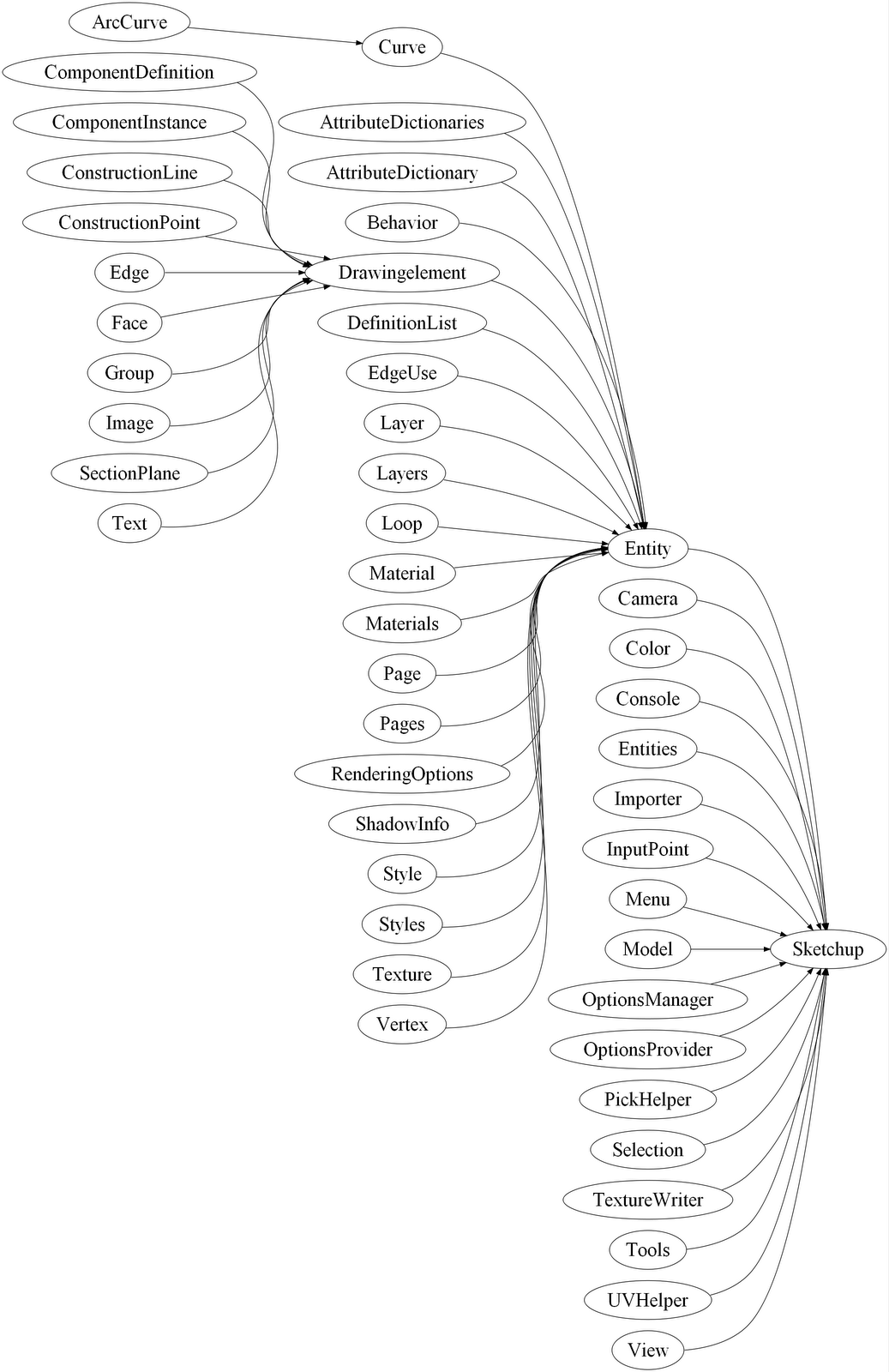Nested Attribute Dictionaries
-
@dan rathbun said:
Basically a tree structure of dictionaries.
Wow, I didn't realize this...
Doesn't really seem intended behaviour, but you could write an entire XML structure within a single attribute! -
You can add an AttributeDictrionary to any object that is a sub-class of Entity. Here is a diagram I made (same as attached) of the relationships, and here is the one from the official API documentation.
So not only can you add attributes to Drawingelements like Faces, Edges, Groups, etc, but also to things like the Layers and Materials collection.
Just be aware that adding too many dictionaries can bloat the .skp file size tremendously.

-
@jim said:
So not only can you add attributes to Drawingelements like Faces, Edges, Groups, etc, but also to things like the Layers and Materials collection.
Yeah, but nesting "attribute dictionaries" under "attribute dictionaries" seems to create a perfect tree-structure for storing (for example) xml data.
@jim said:
Just be aware that adding too many dictionaries can bloat the .skp file size tremendously.
That would be a problem here, because storing data like this would create a LOT of additional attributes.
Would serializing the data(using marshall) and storing this all inside a single attribute be more filesize-efficient?
I can't seem to find a maximum length for an attribute string... -
@brewsky said:
Would serializing the data(using marshall) and storing this all inside a single attribute be more filesize-efficient?
I can't seem to find a maximum length for an attribute string...These are things you would need to experiment with. I don't know the best approach to minimize the impact of using a lot of attributes. Some external database connection seems appropriate for a lot of data, but there is no persistent key for objects between SketchUp sessions, and so the data is not portable.
-
@jim said:
So not only can you add attributes to Drawingelements like Faces, Edges, Groups, etc, but also to things like the Layers and Materials collection.
I'm not sure if SketchUp will actually store attributes to all of these elements. I can't remmeber right now - but I think I experienced once that I wasn't able to successfully store attributes to something that I expected would. Need to dig into old code snippets..
-
@brewsky said:
I can't seem to find a maximum length for an attribute string...
@jim said:
These are things you would need to experiment with.
It's possible to store at least a string containing 100000 characters(looping much more than that freezes my pc).
` i = 0;
s = ""while i < 100000 do
s = s + "a"
i +=1;
endmodel = Sketchup.active_model
model.set_attribute "testdictionary", "test", s
v = model.get_attribute "testdictionary", "test"puts s.length
puts v.length`returns:
100000
100000The file size increases substantially, storing a single string of 100000 long takes it from 8 to 200 kB.
But maybe a text-file would increase similarly, it's a pretty long string... -
@brewsky said:
The file size increases substantially, storing a single string of 100000 long takes it from 8 to 200 kB.
But maybe a text-file would increase similarly, it's a pretty long string...IF the skp files are encoding text in UTF-16 then there would be 2 bytes per ASCII character.
IF it encodes in UTF-8, there are supposed to be only 1 byte for the characters in the ASCII set.
-
SKP files are for the most of it two-byte UTF-16 encoded. (Some old data blocks appear to be ASCII.) All though, the strings you get from the Ruby API is UTF-8 encoded.
-
So then is there a normal, and a backup dictionary in the file ?
-
@dan rathbun said:
So then is there a normal, and a backup dictionary in the file ?
Backup?
Not sure what you mean.
But when I have inspected .skp files I saw no duplicate of any attributes blocks - and the attributes data blocks where in UTF-16.
-
@brewsky said:
` i = 0;
s = ""while i < 100000 do
s = s + "a"
i +=1;
end`it's easier in Ruby to do:
s = 'a' * 100000
-
-
@thomthom said:
Backup? Not sure what you mean.
Yes I meant duplicate internal backups, like how a floppy disk has a backup of the master boot record, that can be restored if the primary gets corrupted. (Not that many are using floppies these days, but it's an example.)
-
@dan rathbun said:
it's easier in Ruby to do:
s = 'a' * 100000 Ruby continues to amaze me, it 'reads' so logical!
Ruby continues to amaze me, it 'reads' so logical!
Still much to learn... -
@thomthom said:
But when I have inspected .skp files I saw no duplicate of any attributes blocks - and the attributes data blocks where in UTF-16.
I wonder if we could use
Zlibto compress data before writing it to dictionaries ??Unzipping it on a read ?
-
Another neat usage of * is for joining arrays:
[1,2,3,4,5] * ' - '
Returns:
"1 - 2 - 3 - 4 - 5" -
@dan rathbun said:
@thomthom said:
But when I have inspected .skp files I saw no duplicate of any attributes blocks - and the attributes data blocks where in UTF-16.
I wonder if we could use
Zlibto compress data before writing it to dictionaries ??I'd love to be able to use zipping in my projects. Think I looked at it some time ago and people had tried to find ways to make it work properyl within SketchUp ruby with mixed results..
Advertisement







